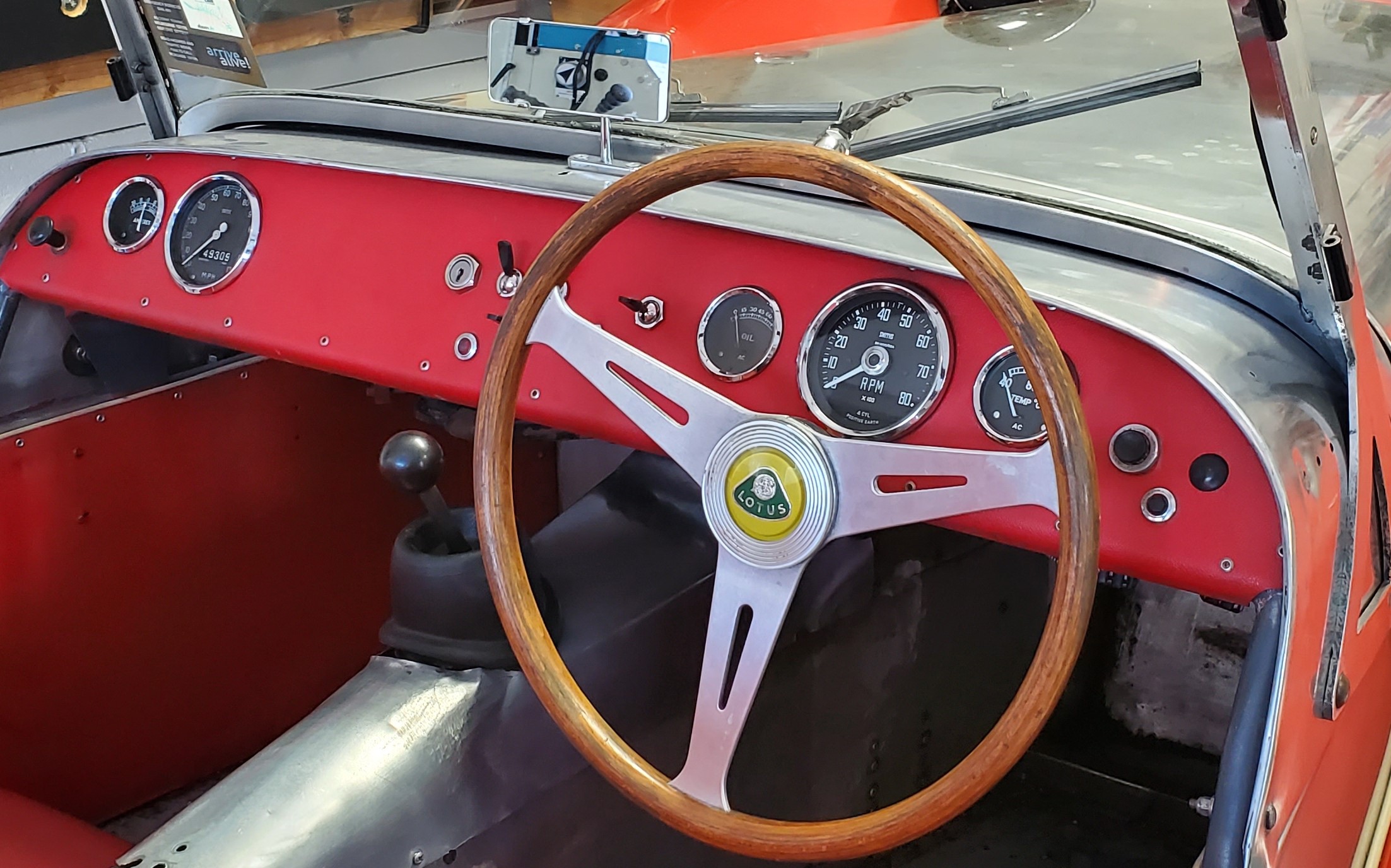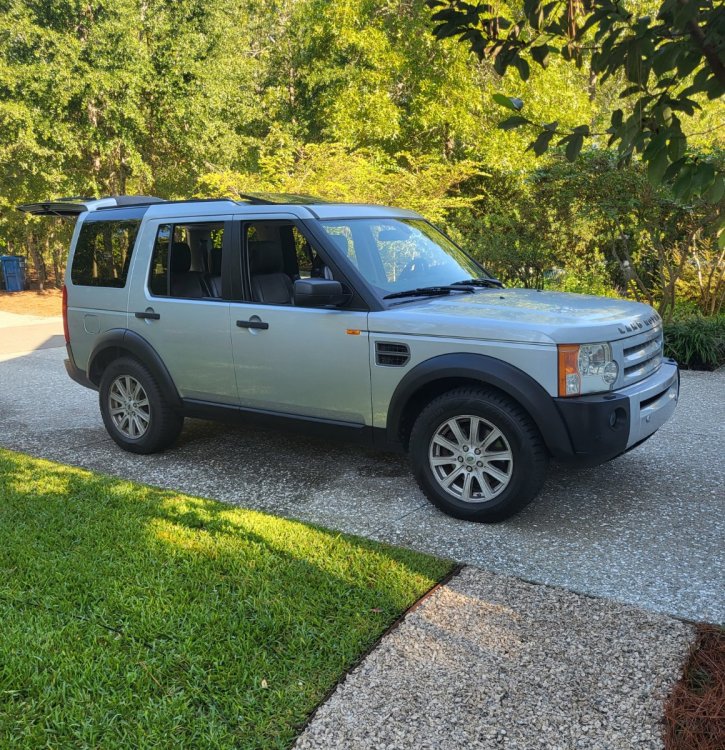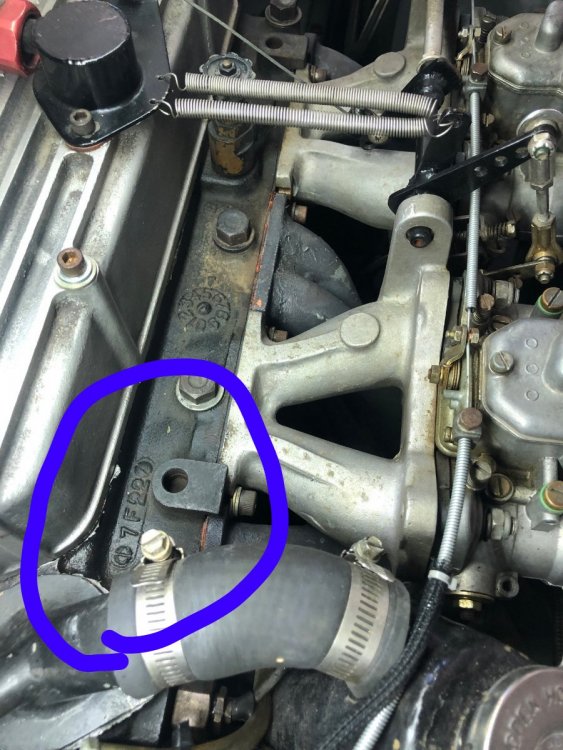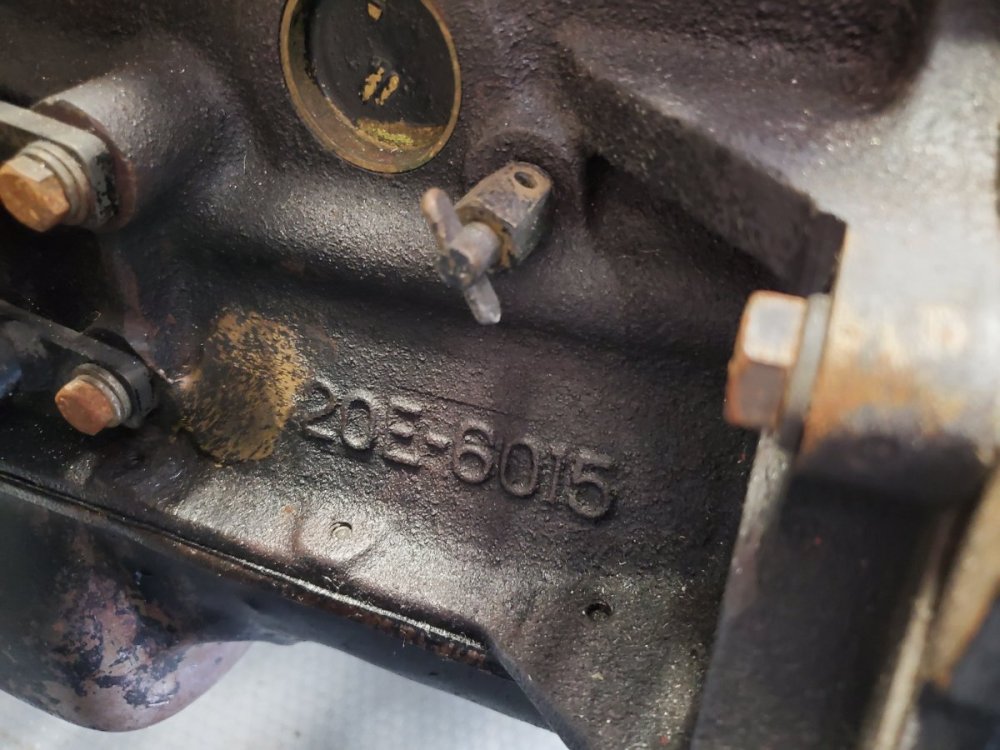-
Posts
633 -
Joined
Content Type
Profiles
Forums
Store
Articles
Gallery
Events
Library
Everything posted by SENC
-
Not really, but I didn't put a ton of miles on it before removing the thermostat. That said, as I was attempting to solve the leak with the t-stat I remember thinking that the thermostat was a restriction in the system even when open (due to the cooling system design) and wondering if that restriction would impact how the swirlpot and system overall functioned. Mine comes up to temp reasonably quickly and then holds steady in the desired range very well - I only turn on the (small original electric) fan when I'm sitting still in traffic on a hot day. In that latter case I do need to blip the throttle periodically to get it above 2k to make sure the pump is pushing water, but I haven't had the temp fluctuations I sometimes experience in my Elan. It doesn't take much forward movement and natural airflow for temps to return right where I want to see them. Unlike the need to worry more about temp differentials due to our aluminum twink heads in the Elan and Europa, I think the precrossflow and crossflow heads heat up more evenly with the block so suspect there is a little less to worry about - but I'd defer to your better background and experience whether I'm just being hopeful.
-
Precrossflows did not have then either, at least not those with swirlpots. That didn't stop people from adding them, and mine had one between swirlpot and head when I got it. I could never get that connection not to leak (gaskets, wellseal, hylomar) with the thermostat and, seeing no particular value to having it in my warmer climate I ditched it. I'm careful to let it warm before pushing it much, but it doesn't take long.
-
https://usa7s.net/ips/topic/13390-early-lotus-seven-identification-plates-chassis-numbers-frame-numbers-and-engine-numbers/?do=findComment&comment=122817
-
Mine is RHD and the frame number is just to the side of the master cylinder mount. I've not looked closely at any LHD versions to see if the stamping was done on the left side on them, but it may be that the stamping stayed in the same location (right side) regardless of driving side. Perhaps John D or one of the others with older cars will be along and know for sure. @eatonhong, @Christopher smith - do you know? Of course, it is certainly a possibility that the frame was replaced at some point. Our Sevens were much more highly and frequently modified either proactively or after an incident than the Europas and Elans. This makes them much harder to establish as original Lotus unless you're lucky enough to be able to track ownership and get good information from prior owners - on the other hand, they were generally modified to improve them, so as "provenance" erodes sometimes fun/reliability improve. Other than the registrars and protectors of the marque who rightfully focus on provenance, my experience is that most owners have these cars simply because they are exhilarating and raw and don't much care weather a frame is origin or not. Additional info... From simple sevens: http://www.simplesevens.org/anglocanadian/angloParts.htm There were two factory approved constructors of the mild steel Series 2 and 3 chassis, Arch Motors, and Universal Radiator. Arch Motors preceded their chassis number with the letters A/M. Universal Radiator used the letter 'B' (possibly followed by an 'L' if the chassis was left hand drive) with four numerals for the chassis number. This letter/number combination was normally stamped on the angular steel bracket that held the front mounting of the master cylinder bracket.
-
The registry site doesn't change, but John is still quite active. He has records on many cars as well as access to the Lotus logbook (to the extent it still exists) - as I recall to get started he will ask you to complete a form (that is probably available on the register site) and provide some evidence of ownership. The simplesevens site is maintained by John Donohoe, a stateside expert on these cars. John is also a participant here and great resource - @SevenAmerica
-
Great looking Seven! If you haven't already, be sure to reach out to John Watson, the historic Seven registrar - he will be able to help you more than anyone. But the number plate and LSB2xxx certainly fit the sequence properly for an LHD Lotus S3. I'm sure you're aware, but John maintains the historic lotus 7 registry site - http://www.lotus7register.co.uk/ser3page.htm - a tremendous resource for history and with some pictures that might help you. Also check out simplesevens.com, a site with pictures and histories of many Sevens. Are you the same jbcollier from the europa forum? Good luck with the car and your information search, and keep us posted!
-

The Regular Summary of Classified Ads of Se7ens Found For Sale
SENC replied to Croc's topic in Cars For Sale
https://bringatrailer.com/listing/1963-lotus-super-seven-2/ -
Excellent! Will enjoy following along!
-
I've been using Redline 5w30 in my Elan for the last few years and more recently in my Seven. It is expensive, but high quality and has the necessary zddp. I was using Brad Penn before that in the Elan, but as I recall I started searching for a different oil when the Penn formulation changed and I couldn't confirm zddp content. The Redline came highly recommended by many at lotuselan.net.
-

Series 2 Pre-Cross Flow Distributor and Ignition Timing
SENC replied to Henry VII's topic in General Tech
116E 6050 J, which would make it a 1500GT head according to the picture Dingo posted. I'm interested in where that came from any any other information, as well. -

Series 2 Pre-Cross Flow Distributor and Ignition Timing
SENC replied to Henry VII's topic in General Tech
Dingo, I don't remember seeing this before, do you know the source? What do HC and LC stand for, high and low compression? -
Good article, MV8 - it still looks to me to be mostly an efficiency/fuel saving device though I can see that there could be some performance gains in engines with long duration cams. You have more experience and knowledge about these than I do - as cams get "wilder" don't we lose vacuum, so counteracting that benefit a bit? Or am I misunderstanding? @IamScotticus you can find meters that just measure dwell, or many multimeters either measure dwell or its inverse - so if you have a good MM check it for function before buying a new tool. I find it extremely useful. As MV8 said, using the feeler gauge and getting a prescribed gap should cause the right dwell to result - but checking dwell directly is confirmation. Surely user-error, but I often find I get close but sometimes just outside the desired dwell range with my feeler gauge - so with a meter I can adjust and get it right. This can affect performance - to short a dwell and the coil doesn't get full charge, too long a dwell and you've impacted timing. As I recall my twin cam and pre-crossflow engines both want 60 degrees of dwell, plus or minus 3 degrees, so suspect crossflow is similar if not the same.
-
Give Martin Jay at Distributor Doctor a call, I'll bet he can build one up to the spec you need. Then keep a couple extra sets of good points, condensers, and rotors and you're set. They really don't fail often with good parts, and are so much simpler to dx and rx problems. Build up a backup dizzy to have in your travel kit and if you have an issue you can swap quickly and save evaluation and points/condenser replacement for the bench.
-
@ProfGriff - what Discovery do you have? I just picked up an 07 LR3 as a tow vehicle and partial DD. This has about 130k miles (almost 100k fewer than the 2010 F250 it will replace) and, hopefully, is nearing the bottom of its depreciation cycle. Will need to do a little work on it, but fortunately there is an active owner network and you can still do a good bit of the work on these yourself - and we have a solid local independent specialist for those things I can't do. Any tips or things to look out for?
-
A different gearbox from mine, but looks like similar failure points. It appears the rear seal has failed and a piece is falling out below the yoke. You could, conceivably, pull the yoke and drives haft out the back and replace that seal, but it would be tough - and given other apparent leaks it would probably be best just to pull the engine and gearbox entirely. I'm surprised there isn't something covering that vent hole - conceivably you could have oil getting flung up that hole and then dripping down the sides rather than additional leaks.
-
If your gearbox is similar to this one from my 65 Seven, the blue arrow points to the breather bolt in one corner of the box cover - you may alternately find it on the remote connection to the tailshaft (I think this is the correct location, actually - my pic was a dry fit of final components to store everything in one piece while completing engine rebuild). The red arrows point to common leak areas. At the end of the tailshaft there are a few common reasons: 1 - the seal has become deformed where the yoke as put pressure on it sitting in one spot for an extended period; 2- the yoke itself is worn at the same spot as the seal hits; 3 - the bushing was installed incorrectly. The speedo angle drive connection is another common weak point- could be a bad o-ring or missing gasket. The biggest volume leak problem is often at the gearbox to bellhousing connection as one of the bolts (bottom left from the front as I recall, but could be right) enters a through hole into the gearbox (rather than a tapped blind hole as the other 3). If this bolt wasn't installed with sealant, it will leak badly. Hope this helps a bit, but (at least on my car) any of these would require engine and gearbox out of the car for resolution. I would certainly try a complete drain and refill to see if it was just overfilled and being forced out.
-
I use https://www.pure-gas.org/ to find non-ethanol gas when I'm in an area I don't know, has seemed pretty accurate. I would put ethanol in my (old) cars in a pinch, but I'd run it out and replace it as quickly as I could.
-
I'm running mine on ethanol-free unleaded with Redline lead substitute and some boostane octane additive, but too soon after rebuild to have any good feedback on impact. I think the general consensus on our Elans is that the original engines have proven fine on unleaded without modification, if that helps at all.
-

Series 2 Pre-Cross Flow Distributor and Ignition Timing
SENC replied to Henry VII's topic in General Tech
Kent engine articles 1- from Dave Bean English Ford catalog (which has lots of other good information and you might want as reference - I think you can still order one from DBE): http://www.team.net/www/morgan/history/kenteng.html 2 - specfic to Cortinas but still quite useful: https://www.lotus-cortina.com/library/block/blocks.htm The lotuselan.net forum is also quite useful, as the twincam used essentially the same block. You'll find plenty of discussion there about block numbers and specific engine numbers. I meant to add earlier that I think this number on your head represents a casting date - I believe June 22 1967 - but stand ready to be corrected if someone knows differently. -

Series 2 Pre-Cross Flow Distributor and Ignition Timing
SENC replied to Henry VII's topic in General Tech
Interesting - share a picture if you can, someone might recognize something that helps you on your search for information. The specific engine number on top of the motor mount can so give a clue, as they were numbered with different conventions for various cars and when sold as replacement blocks. There are a couple good web resources on them, I'll see if I can find them and share links. I misread your prior post about the oil pump and whether that meant you had a 105e engine - I read it as oil cooler. -

Series 2 Pre-Cross Flow Distributor and Ignition Timing
SENC replied to Henry VII's topic in General Tech
Mine originally had an oil cooler based one early pictures, but long since gone - so that doesn't indicate anything in and of itself. A 105e engine block would indicate the 1340cc variety, not the 1500. You should be able to find the appropriate engine marking on the manifold side of the block, on the back half - likely 105e-6015 or 120e-6015, but there are other possibilities if replaced. On the distributor side, on the top of the piece of the block where the motor mount attaches, is the unique block number. If you haven't already, reach out to John Watson (registrar of lotus 7s at the lotus7registry) with the details of your car and he'll be able to help with history. Your intake manifolds dont look like the original Cosworth, so it is possible this engine was upgraded to Cosworth specs later - or that it was simply converted to dual webers and a Cosworth cover added - or that it is/was Cosworth and the manifold replaced for some reason. -

Series 2 Pre-Cross Flow Distributor and Ignition Timing
SENC replied to Henry VII's topic in General Tech
For what it's worth, I'm not sure I see the value of electronic fuel pumps and electronic ignition on these cars - I think the mechanical variety do the job just as well on these simple machines, and they are simpler to maintain and adjust and have fewer gremlins (imo). Having said that, my car is and will remain positive earth and with a generator/dynamo for the same reason of simplicity of function, so I may be a dinosaur. Your dry sump means you don't have to worry about the dreaded rope seal, so you're good on that (mine is good so far, but ticking like all of them). If you have the Standard/TR10 rear axle the download on that may be useful - seal replacement isn't bad, though hub removal can be a bugger and you really want the right tool (I have one if you need). Keep us posted with pictures and any needs. Henry -

Series 2 Pre-Cross Flow Distributor and Ignition Timing
SENC replied to Henry VII's topic in General Tech
Last - you mention a fuel pressure regulator - if it still has the mechanical pump it should not need a regulatory, but may if someone installed an electric pump with too much pressure. -

Series 2 Pre-Cross Flow Distributor and Ignition Timing
SENC replied to Henry VII's topic in General Tech
Check out the downloads available in this section; https://usa7s.net/ips/files/category/5-lotus-seven/ The S2 service manual is there as well as an article on the Cosworth variants - both reference timing and are useful. Also check out the technical section on engines - the 105e engine rebuild manual (for the Ford Consul but basis for our engines) is there and you find pictures and notes about the timing marks.







